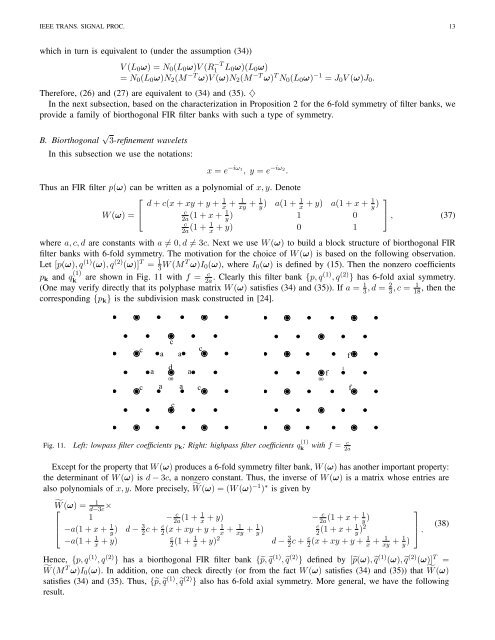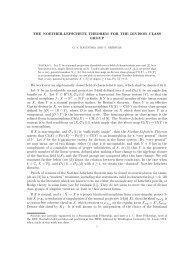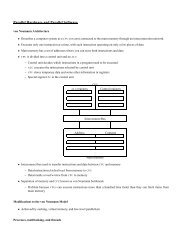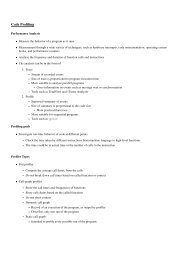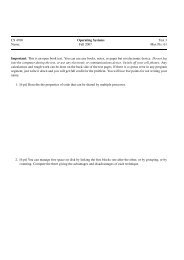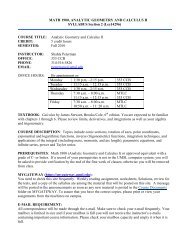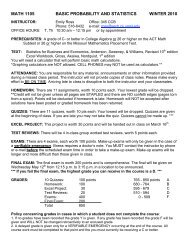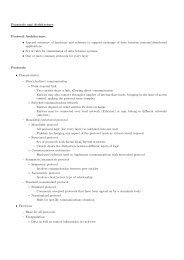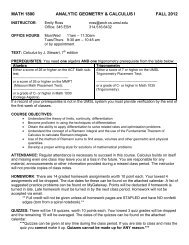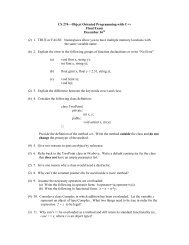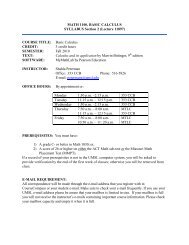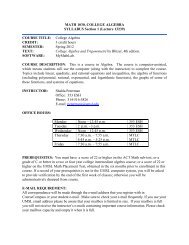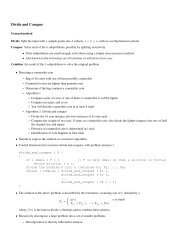here - UMSL : Mathematics and Computer Science - University of ...
here - UMSL : Mathematics and Computer Science - University of ...
here - UMSL : Mathematics and Computer Science - University of ...
Create successful ePaper yourself
Turn your PDF publications into a flip-book with our unique Google optimized e-Paper software.
IEEE TRANS. SIGNAL PROC. 13<br />
which in turn is equivalent to (under the assumption (34))<br />
V (L 0 ω) = N 0 (L 0 ω)V (R −T<br />
1 L 0 ω)(L 0 ω)<br />
= N 0 (L 0 ω)N 2 (M −T ω)V (ω)N 2 (M −T ω) T N 0 (L 0 ω) −1 = J 0 V (ω)J 0 .<br />
T<strong>here</strong>fore, (26) <strong>and</strong> (27) are equivalent to (34) <strong>and</strong> (35). ♦<br />
In the next subsection, based on the characterization in Proposition 2 for the 6-fold symmetry <strong>of</strong> filter banks, we<br />
provide a family <strong>of</strong> biorthogonal FIR filter banks with such a type <strong>of</strong> symmetry.<br />
B. Biorthogonal √ 3-refinement wavelets<br />
In this subsection we use the notations:<br />
x = e −iω 1<br />
, y = e −iω 2<br />
.<br />
Thus an FIR filter p(ω) can be written as a polynomial <strong>of</strong> x, y. Denote<br />
⎡<br />
d + c(x + xy + y + 1 x + 1<br />
xy + 1 y ) a(1 + 1 x + y) a(1 + x + 1 y ) ⎤<br />
W (ω) = ⎣<br />
c<br />
2a (1 + x + 1 y ) 1 0 ⎦ , (37)<br />
c<br />
2a (1 + 1 x + y) 0 1<br />
w<strong>here</strong> a, c, d are constants with a ≠ 0, d ≠ 3c. Next we use W (ω) to build a block structure <strong>of</strong> biorthogonal FIR<br />
filter banks with 6-fold symmetry. The motivation for the choice <strong>of</strong> W (ω) is based on the following observation.<br />
Let [p(ω), q (1) (ω), q (2) (ω)] T = 1 3 W (M T ω)I 0 (ω), w<strong>here</strong> I 0 (ω) is defined by (15). Then the nonzero coefficients<br />
p k <strong>and</strong> q (1)<br />
k<br />
are shown in Fig. 11 with f = c<br />
2a . Clearly this filter bank {p, q(1) , q (2) } has 6-fold axial symmetry.<br />
(One may verify directly that its polyphase matrix W (ω) satisfies (34) <strong>and</strong> (35)). If a = 1 3 , d = 2 3 , c = 1<br />
18<br />
, then the<br />
corresponding {p k } is the subdivision mask constructed in [24].<br />
c<br />
c<br />
a<br />
a<br />
a<br />
c<br />
d<br />
00<br />
a<br />
a<br />
a<br />
c<br />
c<br />
f<br />
00<br />
1<br />
f<br />
f<br />
c<br />
Fig. 11. Left: lowpass filter coefficients p k ; Right: highpass filter coefficients q (1)<br />
k<br />
with f = c<br />
2a<br />
Except for the property that W (ω) produces a 6-fold symmetry filter bank, W (ω) has another important property:<br />
the determinant <strong>of</strong> W (ω) is d − 3c, a nonzero constant. Thus, the inverse <strong>of</strong> W (ω) is a matrix whose entries are<br />
also polynomials <strong>of</strong> x, y. More precisely, ˜W (ω) = (W (ω) −1 ) ∗ is given by<br />
⎡<br />
˜W (ω) = 1<br />
d−3c ×<br />
1 − c<br />
2a<br />
⎢<br />
(1 + 1 x + y)<br />
⎣ −a(1 + x + 1 y ) d − 3 2 c + c 2 (x + xy + y + 1 x + 1<br />
xy + 1 y )<br />
−a(1 + 1 x + y)<br />
− c<br />
2a (1 + x + 1 y )<br />
c<br />
2 (1 + x + 1 y )2<br />
c<br />
2 (1 + 1 x + y)2 d − 3 2 c + c 2 (x + xy + y + 1 x + 1<br />
xy + 1 y ) ⎤<br />
⎥<br />
⎦ .<br />
Hence, {p, q (1) , q (2) } has a biorthogonal FIR filter bank {˜p, ˜q (1) , ˜q (2) } defined by [˜p(ω), ˜q (1) (ω), ˜q (2) (ω)] T =<br />
˜W (M T ω)I 0 (ω). In addition, one can check directly (or from the fact W (ω) satisfies (34) <strong>and</strong> (35)) that ˜W (ω)<br />
satisfies (34) <strong>and</strong> (35). Thus, {˜p, ˜q (1) , ˜q (2) } also has 6-fold axial symmetry. More general, we have the following<br />
result.<br />
(38)


